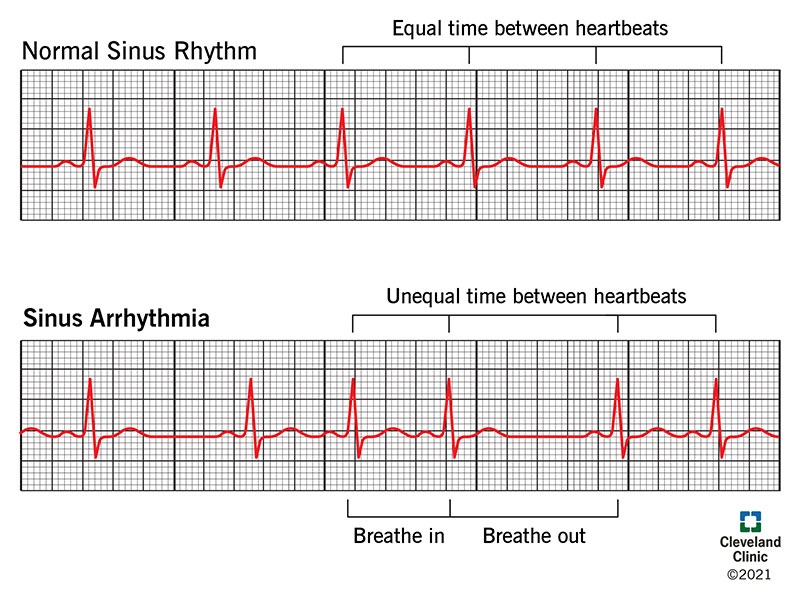While it may seem odd to call an abnormal heart rhythm a sign of a healthy heart, this is actually the case with sinus arrhythmia. Your heart beats at a different rate when you breathe in than when you breathe out. And it’s normal. If your heart doesn’t have sinus arrhythmia, it’s a reason for concern.
Advertisement
Cleveland Clinic is a non-profit academic medical center. Advertising on our site helps support our mission. We do not endorse non-Cleveland Clinic products or services. Policy

Sinus arrhythmia is a kind of arrhythmia (abnormal heart rhythm). For the most common type of sinus arrhythmia, the time between heartbeats can be slightly shorter or longer depending on whether you’re breathing in or out. Your heart rate increases when you breathe in and slows down when you breathe out. This kind of arrhythmia is considered normal. It’s usually a sign that your heart is healthy.
Advertisement
Cleveland Clinic is a non-profit academic medical center. Advertising on our site helps support our mission. We do not endorse non-Cleveland Clinic products or services. Policy
Respiratory sinus arrhythmia is usually normal and doesn’t have symptoms, but the conditions below aren’t normal and do have symptoms.
Using EKG results, your provider will make sure you don’t have:
Providers see this a lot in healthy children and young adults.
It’s very common in young, healthy people. It’s actually a sign of good heart health.
Usually, there are no symptoms.
It’s rare for people to have symptoms of sinus arrhythmia.
Providers separate different kinds of sinus arrhythmia based on their causes.
It’s normal to have respiratory sinus arrhythmia simply because you’re breathing. When you take a breath, your heart rate goes up. When you breathe out, it slows down.
The time between each heartbeat is known as the P-P interval. In most people, there’s a slight variation of less than 0.16 seconds. In cases of respiratory sinus arrhythmia, the P-P interval will often be longer than 0.16 seconds when the person breathes out.
In EKG results, nonrespiratory sinus arrhythmia can look like respiratory sinus arrhythmia. But people with this type usually:
Advertisement
Providers can identify ventriculophasic sinus arrhythmia by looking at the electrocardiogram (EKG) results. People with this kind of sinus arrhythmia usually have third-degree AV block.
Healthcare providers often find sinus arrhythmia while doing a routine electrocardiogram (EKG).
An electrocardiogram (EKG) can tell your provider if you have sinus arrhythmia.
Since respiratory sinus arrhythmia is normal, people without symptoms rarely need treatment.
With nonrespiratory sinus arrhythmia or ventriculophasic sinus arrhythmia, generally, you don’t need any further testing or intervention.
If you have respiratory sinus arrhythmia, your outlook is good. You have a healthy heart.
You can’t prevent respiratory sinus arrhythmia. And you don’t want to, because it’s a sign of a healthy heart.
No. Respiratory sinus arrhythmia is actually a sign of a healthy heart.
No. Respiratory sinus arrhythmia doesn’t cause chest pain.
You might be concerned when your healthcare provider notices an abnormal heart rhythm in your routine EKG. But respiratory sinus arrhythmia is not a cause for worry. The time between heartbeats can be different depending on whether you’re breathing in or out. So this “abnormal” rhythm is actually a sign of a heart that’s working right.
Advertisement
When your heart rhythm is out of sync, the experts at Cleveland Clinic can find out why. We offer personalized care for all types of arrhythmias.

Last reviewed on 03/21/2022.
Learn more about the Health Library and our editorial process.